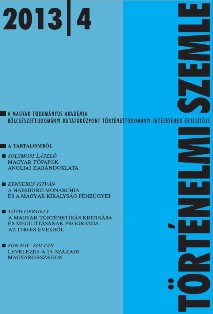Magyar főpapok angliai zarándoklata 1220-ban
The Pilgrimage of Hungarian Prelates to England in 1220
Author(s): László SolymosiSubject(s): History
Published by: Magyar Tudományos Akadémia Bölcsészettudományi Kutatóközpont Történettudományi Intézet
Summary/Abstract: The cathedral of Canterbury was the venue for an international event of great signifi cance on 7 July 1220. On that day the earthly remains of Saint Thomas Becket, martyred archbishop of Canterbury (1162–1170), were translated from the crypt of the church to the Holy Trinity Chapel. According to the narrative of Walter of Coventry, prepared in the late 13th century on the basis of contemporary information, the ceremony of translation (translatio) was attended, alongside a great crowd of pilgrims and the papal legate, by three archbishops: cardinal Stephen Langton of Canterbury (1207–1229), Guillaume de Joinville of Rheims (1219-1226), and a Hungarian archbishop, and by 17 bishops. Walter of Coventry failed to name the diocese of the Hungarian archbishop and those of the bishops, and in the lack of other sources their identification is almost hopeless, even in the case of the archbishop, for there were two ecclesiastical provinces in Hungary: Esztergom and Kalocsa. Alongside the archbishop, another Hungarian prelate also participated in the celebration. According to a bull of pope Honorius issued late in 1220, bishop Desiderius of Csanád (1202–1229) was robbed by burghers of Pavia when, in the course of a pilgrimage, he travelled through the city of Pavia on his way back from the translation of the body of Saint Thomas of Canterbury. According to the author of the present study, the Hungarian archbishop in question may have been John of Esztergom (1205–1223), at whose seat in Esztergom there was a provostry erected in the honour of Thomas Becket. This establishment must have been interested in acquiring some of the earthly relics of its patron saint. Robert, bishop of Veszprém (1209– 1226), who had originally come from the diocese of Liege, probably also took part in the ceremony at Canterbury, since besides Esztergom, his seat was the only one in Hungary to host a church establishment dedicated to Saint Thomas Becket. Although the possibility that John, Desiderius and Robert had been the schoolmates or disciples of Langton at Paris cannot be excluded, their personal acquaintance more probably dated from the Fourth Lateran council held in 1215. In any case, the presence of Hungarian prelates and their retinues at the ceremony of Canterbury gave further impetus to the cult of Saint Th omas Becket in Hungary.
Journal: Történelmi Szemle
- Issue Year: 2013
- Issue No: 04
- Page Range: 527-540
- Page Count: 14
- Language: Hungarian

